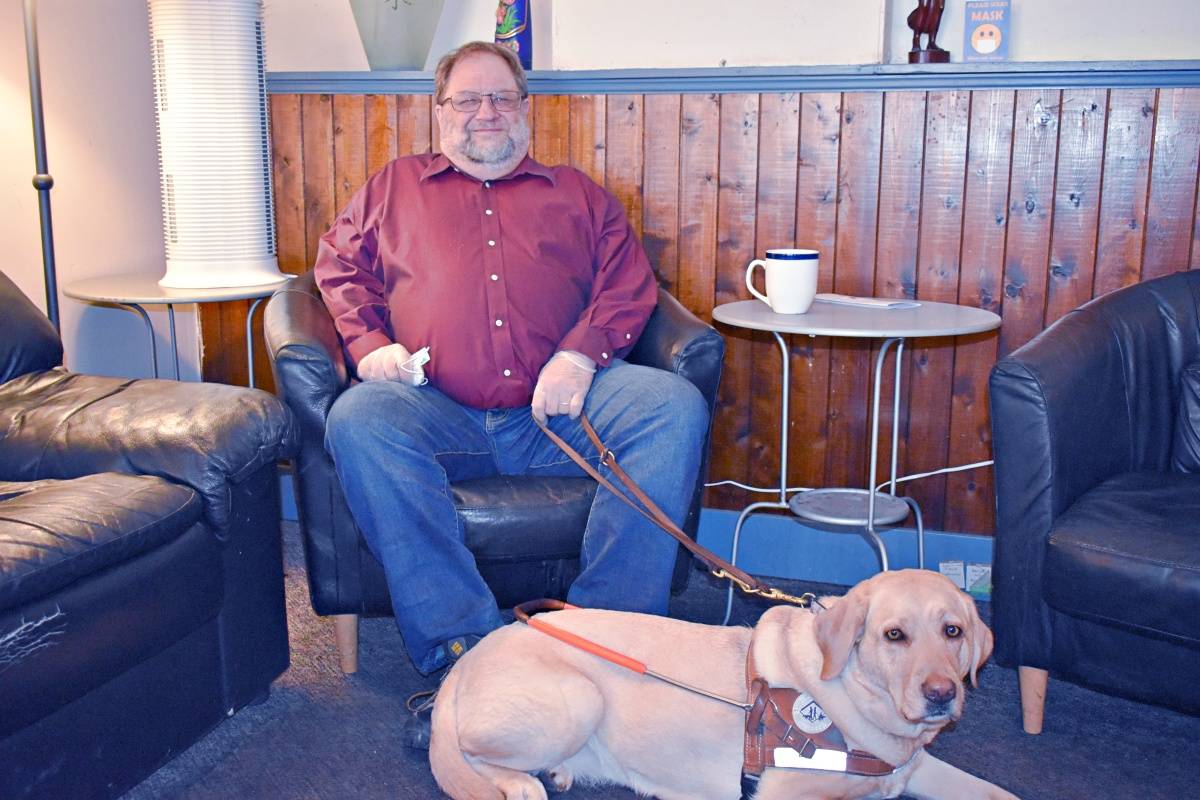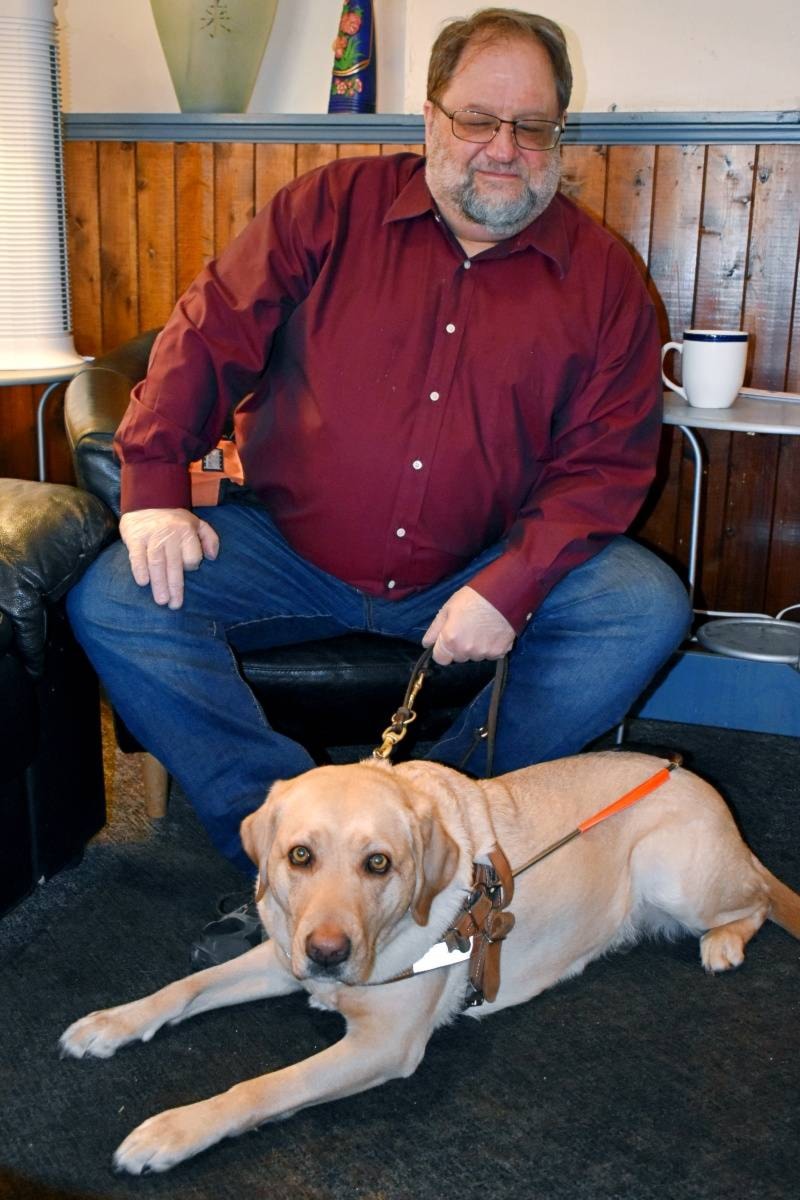It has now been two years since Annie came to live with Ed Landrath and his family. The four-year-old seeing-eye dog has made navigating life in Prince Rupert much smoother for the legally blind resident.
But while his canine companion has made life easier for Ed, it hasn’t been without challenges, Landrath said. Annie is the only assistance dog that he knows of in Prince Rupert, and the protocols surrounding her as a working dog are unfamiliar to many.
Even as Ed sat down with The Northern View to chat in a local eatery, after Annie positioned herself quietly under the table, staff questioned him not just once, but twice, about the allowability of bringing a dog into a food establishment. It was soon all sorted with Landrath reiterating that she was a working service dog and was permitted into the establishment for his assistance. This isn’t the only situation Ed faces when out with his working assistant.
One of the issues Ed faces is when just out walking in public. Community members in front of, or beside him will try to engage with Annie. She is an extremely friendly and sociable dog so can have her attention easily diverted from the job she is supposed to do, which is to keep Ed safe.
“I always try to tell people if you want to pet Annie, talk to me, and I’ll stop and let you pet her. You’re not really supposed to allow this, but, because this is a small town I think it’s important that everybody knows who she is.”
Ed said while Annie is great at doing her job, there are times he especially needs her services as he can’t drive so just walking around town he relies on her. He said he has to give over control and place his complete trust in her.
“A couple of times I have fallen down because the sidewalks are so terrible. While she avoids things the sidewalks are bad. There’s no getting around it. I would have fallen anyway,’ he said. “They are in need of repair.”
For example, Ed said, even with Annie guiding him he walks in the middle of the road in his own neighbourhood because a dog is limited in its abilities to interpret and avoid some dangers along the street paths.
“Annie has made that so much easier. She steers me around puddles, stops at curbs, and finds the best way around people and that sort of thing,” he said. “It’s just the nuances of negotiating your terrain.”
Ed has been blind since he was young. He has no vision in one eye and only three per cent vision in the other. While he could read large print books as a child, he no longer can. He was a voracious reader, he said having read every single book in the school library to the point staff would take him to the bookmobile down the street to obtain more brainfood for him. However, he now uses audiobooks because he has lost all sight.
“Actually, I didn’t realize how bad it (his lack of sight) was until I moved to a town that I didn’t know anything about,” he said. “It was new territory. I didn’t realize how much sight I didn’t have.”
Having attended a school for the visually impaired and being raised while living in the lower mainland, he said everything was well structured, and he was familiar with it.
“I’m very self-sufficient. But, when I get into new situations, it’s really tough,” Ed said.
Langrath and his family moved to Prince Rupert more than four years ago primarily for the health of his son who has cystic fibrosis. The moist salt air helps with his son’s condition, Ed said. The other reason they were attracted to the region was its more relaxed lifestyle.
“The other reason was we were commuting three hours a day, each of us. So we didn’t have any lives.” Ed said about him and his wife Sharon. “We were exhausted. So we made the decision to come up here. We also have family up here, so that made the decision a little easier.”
Still in his fifties and for some too young to retire, Ed did retire from his position as a purchaser for a communications company where he had worked for more than 27 years, to make the move north where he now attends to the medical needs of his son.
“I just didn’t think it was prudent to try to start all over somewhere at my age,” he said.
Ed explained much larger centres are very progressive and have various supports and agencies that can assist with a variety of issues for the visually impaired, including funding for equipment. There are not these resources in the north, he said, so he is left alone to find solutions to his needs. Living with only Sharon’s income and raising two teenagers, expensive needs aren’t easily filled due to finances.
One of his needs is a talking-camera device to assist him when he is out in the community and alone at home. Annie can offer unrequited love he says, but sadly she can not help with the stove knobs or reading instructions on a food package.
“You’re all alone and you’ve got extra challenges,” he said.
The finger-sized device that would offer immense help to him is clipped onto a pair of glasses, Ed said. Technology allows it to read print, interpret the words, and audibly repeat the text back. This would read signs for him, flyers, menus, items in the grocery store, and even newspaper articles which he currently can not see, as well as most importantly read medications for his son’s care. It also has facial recognition which would make conversations out in public easier for him.
“The reason I want the Orcam is I want spontaneity. I want to be able to pick something up and read it.”
For years he has used old technology of cutting out package instructions or restaurant menus, scanning them on a computer, and enlarging the font so he could attempt to read. However, the cumbersome and dated process does not work when out in the community. It also doesn’t work on something as mundane as using the kitchen stove. The knobs are at the back of the stove and he needs to lean across the elements, which could already be hot, to see the settings on the knobs.
While he has visual magnifiers at home, when the font is magnified to 20x his field of vision is such that he can read only one letter at a time. The key to reading is to get as much information as possible he said, which can be difficult for understanding or interpretation.
“Sometimes I’ll have to read a word into two segments. For example one of the words was coworker, of course, I read it as ‘cow orker’,” Ed said laughing. “It would be safe to say I have to read letter by letter.”
Reading letter by letter isn’t a solution for him as severe headaches develop after reading for more than 30 seconds to a minute he said.
But, with the cost of the ‘Orcam MyEye’ device being close to $5,000 dollars based on currency exchange rates and promotional offers which he watches for, the cost is prohibitive with only one income supporting the whole family.
Ed said he know’s that it may take up to a year to gather the funds to cover the cost.
“I’m a purchaser by trade. So I’m always trying to get the best economy,” he said.
A recent Go-Fund-Me has been set up by a local community member to assist with the purchase of the vision-aid so Ed can have as much of a normal life as possible in Prince Rupert. The campaign, initiated on Feb. 11 has raised $380 to March 7.
“This Orcam would greatly improve his day-to-day quality of life, as well with the caring for his son,” the fundraising page reads. “Being blind from birth Ed has come a long way but we know there is so much more out there that can help him. Please consider donating to him to help him and his family life improve his quality of life.”
K-J Millar | Journalist
Send K-J email
Like the The Northern View on Facebook
Follow us on Twitter

